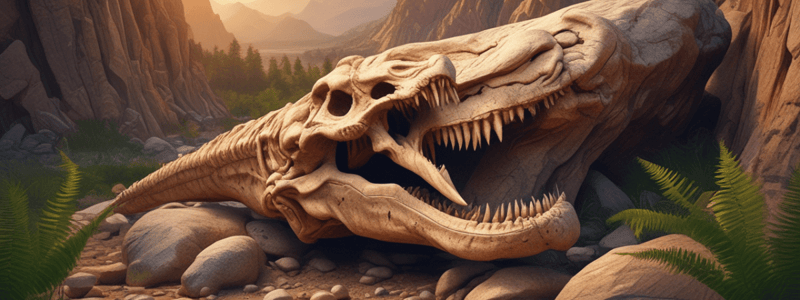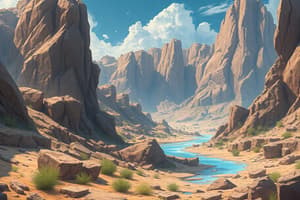Podcast
Questions and Answers
What are the two major types of fossils mentioned in the lesson?
What are the two major types of fossils mentioned in the lesson?
Where are fossils usually found according to the text?
Where are fossils usually found according to the text?
What are the repeated events that make up the water cycle?
What are the repeated events that make up the water cycle?
Where does condensation occur in the water cycle?
Where does condensation occur in the water cycle?
Signup and view all the answers
What are the characteristics of cumulus clouds described in the lesson?
What are the characteristics of cumulus clouds described in the lesson?
Signup and view all the answers
What is the main difference between alto clouds and cirrus clouds?
What is the main difference between alto clouds and cirrus clouds?
Signup and view all the answers
How do meteorologists measure wind speed?
How do meteorologists measure wind speed?
Signup and view all the answers
What is the primary function of wind turbines?
What is the primary function of wind turbines?
Signup and view all the answers
How do air masses move from one area to another?
How do air masses move from one area to another?
Signup and view all the answers
What causes clouds to form according to the text?
What causes clouds to form according to the text?
Signup and view all the answers
What is a cold front?
What is a cold front?
Signup and view all the answers
Which region of the United States is known as Tornado Alley?
Which region of the United States is known as Tornado Alley?
Signup and view all the answers
What powers hurricanes?
What powers hurricanes?
Signup and view all the answers
What is the calm area in the center of a hurricane called?
What is the calm area in the center of a hurricane called?
Signup and view all the answers
What is the best way to stay safe during a lightning storm?
What is the best way to stay safe during a lightning storm?
Signup and view all the answers
What is orographic lifting in relation to cloud formation?
What is orographic lifting in relation to cloud formation?
Signup and view all the answers
What type of cloud is a cumulus cloud?
What type of cloud is a cumulus cloud?
Signup and view all the answers
What is climate in relation to weather?
What is climate in relation to weather?
Signup and view all the answers
Who studies clouds, including cirrus, altostratus, and cumulus clouds?
Who studies clouds, including cirrus, altostratus, and cumulus clouds?
Signup and view all the answers
What happens when two air masses meet and create a front?
What happens when two air masses meet and create a front?
Signup and view all the answers
Study Notes
Fossils
- Fossils are molds of plants and animals that lived thousands of years ago, and are divided into two types: trace fossils and body fossils.
- Trace fossils are evidence of animal activity that is preserved, while body fossils are remains of a plant or animal that were trapped under dirt and preserved over a long period of time.
- Fossils are usually found in sedimentary rock, and have been found on all continents, with a higher concentration in North and South America, and Asia.
- Some fossils are found in amber, which is a resin that preserves animals, and coprolite, which is fossilized animal poop.
The Water Cycle
- The water cycle is a set of repeated events that involve evaporation, condensation, precipitation, and collection.
- Evaporation occurs when water is warmed up and turns into a gas.
- Condensation occurs when water gas gets cold and turns back into a liquid.
- Precipitation occurs when water falls back to the earth.
- Collection occurs when water is stored in lakes, rivers, oceans, soil, and rocks.
Clouds
- There are four main types of clouds: cumulus, stratus, alto, and cirrus.
- Cumulus clouds are puffy and white, like cotton balls.
- Stratus clouds are flat and white, like sheets.
- Alto clouds are made of water droplets and sometimes ice droplets.
- Cirrus clouds are white and wispy, and come with rain-free weather.
The Atmosphere
- The atmosphere is the circle of gas that surrounds planet Earth, and is divided into five layers: Troposphere, Mesosphere, Stratosphere, Thermosphere, and Exosphere.
Solar Radiation
- Solar radiation is sunlight and energy that comes from the sun and travels to Earth in the form of light waves.
- Light waves come in different forms, vibrate, and have different lengths and energy levels.
- Solar radiation is necessary for living things to survive on Earth, and provides visible light, infrared light, and ultraviolet (UV) light.
Wind
- Wind is the movement of air caused by differences in air pressure.
- The wind blows because the sun heats land faster than it heats water, which causes changes in air pressure.
- Meteorologists use instruments like an anemometer to measure wind speed.
- Wind energy can be captured using wind turbines, which spin like giant pinwheels.
Prevailing Winds
- Prevailing winds are dominant winds in a certain area.
- Wind direction is where the wind is coming from, and wind speed is the measurement of how fast the air is moving.
- Tools for measuring wind speed include an anemometer and the Beaufort scale, which rates wind from 0-12.
Air Pressure
- Air has weight, and because of that, exerts pressure.
- Meteorologists measure pressure to predict the weather.
- In a high pressure area, air molecules are held down, resulting in clear, sunny days.
- In a low pressure area, air and water molecules are able to float high into the sky, resulting in cloudy, rainy days.
Air Masses
- Air masses that stay in a particular area begin to take on the characteristics of the temperature and humidity in that area.
- There are six kinds of air masses, each named after the locations in which they form: maritime tropical, continental arctic, maritime arctic, maritime polar, continental polar, and continental tropical.
- Air masses can move from one area of the world to another because of jet streams, which move from west to east.
- When air masses move, they affect the weather because they take with them the characteristics of their birthplaces.
Cloud Formation
- Clouds can be created for a number of reasons, including convectional lifting, cold fronts, warm fronts, stationary fronts, and occluded fronts.
- Convectional lifting occurs when warm, humid air rises and begins to cool, causing the water vapor to condense into clouds.
- Cold fronts occur when a cold air mass takes over a warm air mass, causing it to go up into the atmosphere.
- Warm fronts occur when a warm air mass takes over a cold air mass, leaving warm air.
- Stationary fronts occur when neither the warm air mass nor cold air mass moves.
- Occluded fronts occur when a cold front is created in a low pressure area.
Tornadoes
- A tornado is a spinning column of air that stretches from a thunderstorm to the ground.
- Tornado winds are very strong, which makes them dangerous.
- Tornadoes form in a thunderstorm when an area of warm air meets an area of cold air, and the winds are blowing in just the right way.
- Tornadoes have struck every single U.S. state, including Hawaii, but the area of greatest concern is Tornado Alley, which includes parts of Texas, Oklahoma, Kansas, and Nebraska.
Hurricanes
- Hurricanes are powerful storms that form over oceans and get their energy from the warm ocean waters.
- Hurricane winds blow at 74 to 200 miles per hour and spin due to the Coriolis effect, which is a force created by the spinning of the Earth.
- The calm area in the center of a hurricane is called the eye.
Thunderstorms
- A thunderstorm is a rainstorm with thunder and lightning.
- Thunderstorms need moisture, unstable air, and lift to form.
- Thunderstorms have three stages: developing, mature, and dissipating.
- They can happen almost anywhere in the world and in any season.
- They can occur at any time of day, although most often in the afternoon and evening.
Lightning
- Lightning is a flash of light produced by electricity when negatively-charged electrons and positively-charged protons collide.
- There are different kinds of lightning, including cloud-to-ground, cloud-to-cloud, intra-cloud, and cloud-to-air.
- Lightning is dangerous, and the best way to stay safe is to get inside a big building and stay away from windows.
Ecosystems
- Ecosystems are specific areas that can be either in water (aquatic) or on land (terrestrial).
- An ecosystem is made up of living organisms and non-living things that depend on each other for survival.
- We also learned about food chains, which include producers, primary consumers, secondary consumers, decomposers, and omnivores.
Energy Transfer
- In order to survive, living things need energy, and energy passes from a producer (which are plants that make their own energy from the sunlight) into herbivores (plant-eating animals), carnivores (meat-eating animals), and omnivores (animals that eat both plants and meat).
- We use food chains to represent a single flow of energy and we use food webs to represent the feeding relationship between many living things within a community.
The Energy Pyramid
- The energy pyramid shows us how energy transfers from one organism to the next on the food chain.
Weather
- Weather is the state of the atmosphere at any given time.
- Weather is affected by the Sun's rays and their interaction with the gases in the Earth's atmosphere.
- Weather has many aspects, including wind, pressure, cloud cover, temperature, and precipitation.
Climate
- Climate is the pattern of weather in an area over a long period of time.
- It's impacted by different factors, including temperature, humidity, distance from bodies of water, wind, the amount and types of precipitation, topography, latitude, and elevation.
- There are five main types of climate: tropical, dry, mild, continental, and polar.
Forecasting
- A forecast is a prediction, or good guess, about the future.
- Weather forecasting is when scientists called meteorologists use many different tools to predict what the weather in the near future will be.
- Meteorologists pay attention to the temperature, air pressure, clouds, and other factors to make their predictions.
Meteorologists
- Scientists who study the atmosphere and predict the weather are called meteorologists.
- They use weather maps to show what the weather forecast will be, and these weather maps are important because they show us how to plan our day and week.
- There are several types of weather maps, such as satellite, precipitation, temperature, front maps, wind speed, and Doppler radar.
Studying That Suits You
Use AI to generate personalized quizzes and flashcards to suit your learning preferences.
Description
Learn about the two main types of fossils, trace fossils and body fossils, and how they are formed in sedimentary rocks. Discover how fossils provide evidence of plant and animal life from thousands of years ago.




